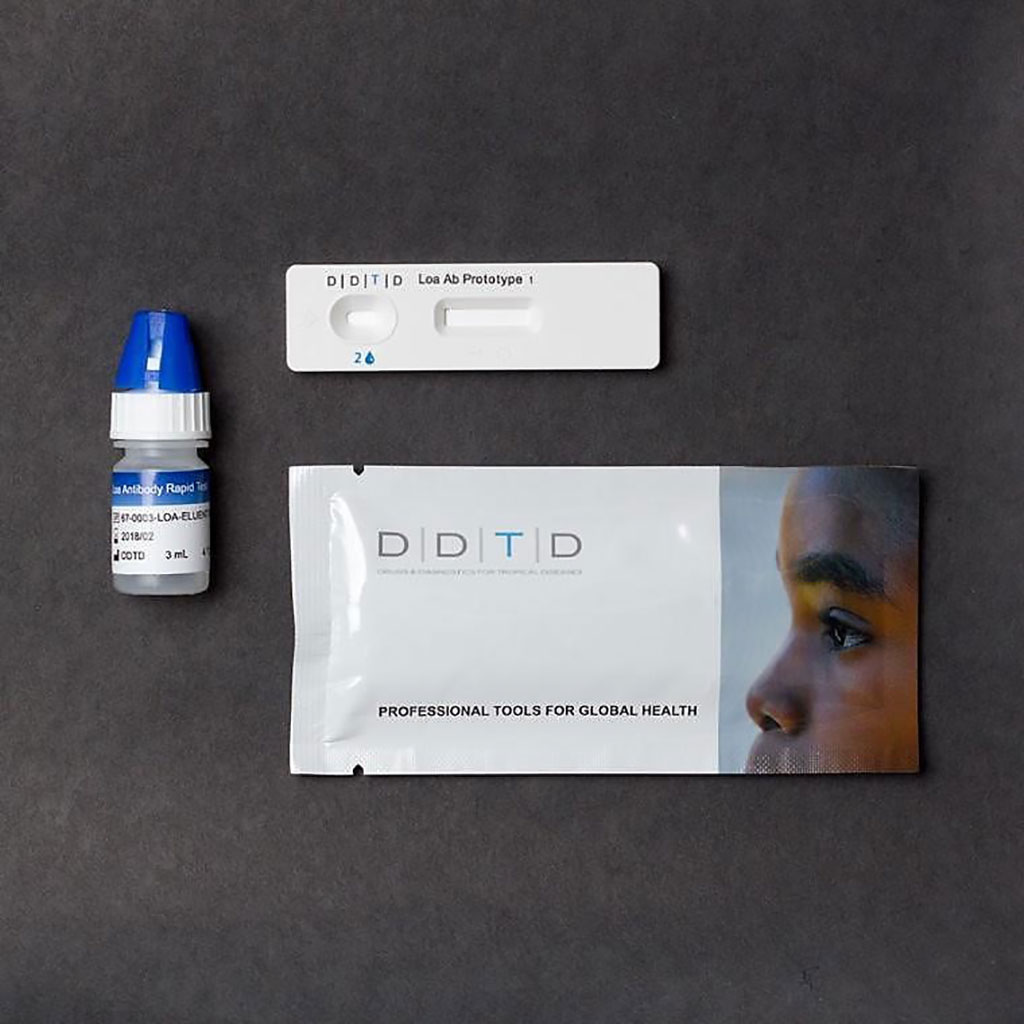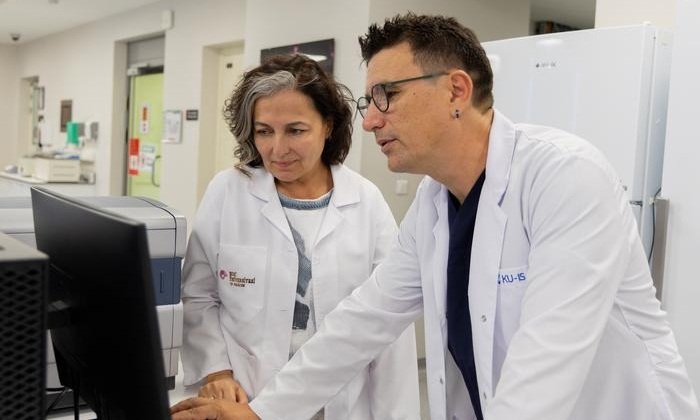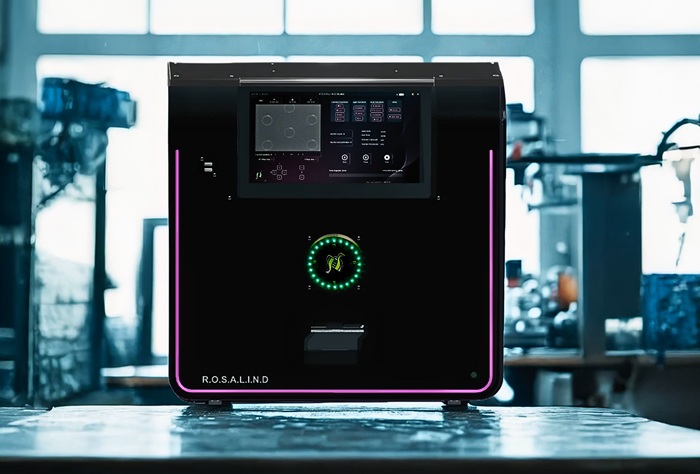Two Serodiagnostic Tests Compared for Loiasis in Non-Endemic Area
|
By LabMedica International staff writers Posted on 18 Jun 2020 |

Image: The Loa Antibody Rapid Test detects human IgG against a 148-aminoacid sequence of Ll-SXP-1 (Photo courtesy of Drugs & Diagnostics for Tropical Diseases).
Loiasis, the disease caused by the infection with the filarial nematode Loa loa, is transmitted through the bite of tabanid flies of the genus Chrysops. It is endemic in Central and West Africa where, according to the most recent estimates, about 10 million people are infected.
There is a scarcity of convenient, commercial diagnostics for L. loa. Microscopy requires trained personnel and has low sensitivity, while the serodiagnosis is currently not standardized. Individual case management is also important in non-endemic countries to treat migrants, expatriates and tourists.
Scientists at the Sacro Cuore Don Calabria Hospital (Verona, Italy) retrospectively compared the performance of an Antibody Rapid Test (RDT) and a commercial ELISA pan-filarial test on 170 patients, 65 with loiasis [8 with eyeworm, 29 with positive microfilaremia, 28 with neither microfilaremia nor history of eyeworm but eosinophilia and history of Calabar swelling (probable loiasis)], 95 with other common parasitic infections and no previous exposure to L. loa (37 with M. perstans, one with Brugia sp., 18 with strongyloidiasis, 20 with schistosomiasis, five with hookworm, four with Ascaris lumbricoides infection, 10 with hyper-reactive malarial splenomegaly), and 10 uninfected controls.
The Loa Antibody Rapid Test (RDT, Drugs & Diagnostics for Tropical Diseases, San Diego, CA, USA) detects human IgG against a 148-aminoacid sequence of Ll-SXP-1, a protein with 51–53% sequence identity with Wuchereria bancrofti and Onchocerca volvulus, the two most clinically relevant filarial species. The commercial ELISA kit uses Acanthocheilonema viteae antigens (Bordier Affinity Products, Crissier, Switzerland) and this test is not specific for single filarial species, and detects IgG against various filarial nematodes affecting humans.
The investigators reported that the sensitivity of the RDT and of the ELISA were 93.8% (61/65) and 90.8% (59/65), respectively. For the RDT, most of the cross-reactions were observed in patients with M. perstans: 7/37 (18.9%), followed by 1/10 (10%) with hyper-reactive malarial splenomegaly and 1/20 (5%) with schistosomiasis. None of the 27 subjects infected with intestinal nematodes was found positive with this test. The ELISA is meant to be a pan-filarial assay, and reacted extensively with cases of M. perstans (95%), as expected, and also in 11/18 (61.1%) patients with strongyloidiasis and in 3/5 (60%) with hookworm infection.
The authors concluded that the novel lateral flow RDT has proven to be an accurate and user-friendly tool for the diagnosis of L. loa infection. While some cross-reactivity with M. perstans should be taken into account when considering its potential application as a screening tool in endemic areas, on the other hand this new test appears to be promising in the of non-endemic setting, where it could be included in a management algorithm. The study was published on May 26, 2020 in the journal PLOS Neglected Tropical Diseases.
Related Links:
Sacro Cuore Don Calabria Hospital
Drugs & Diagnostics for Tropical Diseases
Bordier Affinity Products
There is a scarcity of convenient, commercial diagnostics for L. loa. Microscopy requires trained personnel and has low sensitivity, while the serodiagnosis is currently not standardized. Individual case management is also important in non-endemic countries to treat migrants, expatriates and tourists.
Scientists at the Sacro Cuore Don Calabria Hospital (Verona, Italy) retrospectively compared the performance of an Antibody Rapid Test (RDT) and a commercial ELISA pan-filarial test on 170 patients, 65 with loiasis [8 with eyeworm, 29 with positive microfilaremia, 28 with neither microfilaremia nor history of eyeworm but eosinophilia and history of Calabar swelling (probable loiasis)], 95 with other common parasitic infections and no previous exposure to L. loa (37 with M. perstans, one with Brugia sp., 18 with strongyloidiasis, 20 with schistosomiasis, five with hookworm, four with Ascaris lumbricoides infection, 10 with hyper-reactive malarial splenomegaly), and 10 uninfected controls.
The Loa Antibody Rapid Test (RDT, Drugs & Diagnostics for Tropical Diseases, San Diego, CA, USA) detects human IgG against a 148-aminoacid sequence of Ll-SXP-1, a protein with 51–53% sequence identity with Wuchereria bancrofti and Onchocerca volvulus, the two most clinically relevant filarial species. The commercial ELISA kit uses Acanthocheilonema viteae antigens (Bordier Affinity Products, Crissier, Switzerland) and this test is not specific for single filarial species, and detects IgG against various filarial nematodes affecting humans.
The investigators reported that the sensitivity of the RDT and of the ELISA were 93.8% (61/65) and 90.8% (59/65), respectively. For the RDT, most of the cross-reactions were observed in patients with M. perstans: 7/37 (18.9%), followed by 1/10 (10%) with hyper-reactive malarial splenomegaly and 1/20 (5%) with schistosomiasis. None of the 27 subjects infected with intestinal nematodes was found positive with this test. The ELISA is meant to be a pan-filarial assay, and reacted extensively with cases of M. perstans (95%), as expected, and also in 11/18 (61.1%) patients with strongyloidiasis and in 3/5 (60%) with hookworm infection.
The authors concluded that the novel lateral flow RDT has proven to be an accurate and user-friendly tool for the diagnosis of L. loa infection. While some cross-reactivity with M. perstans should be taken into account when considering its potential application as a screening tool in endemic areas, on the other hand this new test appears to be promising in the of non-endemic setting, where it could be included in a management algorithm. The study was published on May 26, 2020 in the journal PLOS Neglected Tropical Diseases.
Related Links:
Sacro Cuore Don Calabria Hospital
Drugs & Diagnostics for Tropical Diseases
Bordier Affinity Products
Latest Microbiology News
- New UTI Diagnosis Method Delivers Antibiotic Resistance Results 24 Hours Earlier
- Breakthroughs in Microbial Analysis to Enhance Disease Prediction
- Blood-Based Diagnostic Method Could Identify Pediatric LRTIs
- Rapid Diagnostic Test Matches Gold Standard for Sepsis Detection
- Rapid POC Tuberculosis Test Provides Results Within 15 Minutes
- Rapid Assay Identifies Bloodstream Infection Pathogens Directly from Patient Samples
- Blood-Based Molecular Signatures to Enable Rapid EPTB Diagnosis
- 15-Minute Blood Test Diagnoses Life-Threatening Infections in Children
- High-Throughput Enteric Panels Detect Multiple GI Bacterial Infections from Single Stool Swab Sample
- Fast Noninvasive Bedside Test Uses Sugar Fingerprint to Detect Fungal Infections
- Rapid Sepsis Diagnostic Device to Enable Personalized Critical Care for ICU Patients
- Microfluidic Platform Assesses Neutrophil Function in Sepsis Patients
- New Diagnostic Method Confirms Sepsis Infections Earlier
- New Markers Could Predict Risk of Severe Chlamydia Infection
- Portable Spectroscopy Rapidly and Noninvasively Detects Bacterial Species in Vaginal Fluid
- CRISPR-Based Saliva Test Detects Tuberculosis Directly from Sputum
Channels
Clinical Chemistry
view channel
Noninvasive Blood-Glucose Monitoring to Replace Finger Pricks for Diabetics
People with diabetes often need to measure their blood glucose multiple times a day, most commonly through finger-prick blood tests or implanted sensors. These methods can be painful, inconvenient, and... Read more
POC Breath Diagnostic System to Detect Pneumonia-Causing Pathogens
Pseudomonas aeruginosa is a major cause of hospital-acquired and ventilator-associated pneumonia, particularly in lung transplant recipients and patients with structural lung disease. Its ability to form... Read moreMolecular Diagnostics
view channel
World's First NGS-Based Diagnostic Platform Fully Automates Sample-To-Result Process Within Single Device
Rapid point-of-need diagnostics are of critical need, especially in the areas of infectious disease and cancer testing and monitoring. Now, a direct-from-specimen platform that performs genomic analysis... Read more
Rapid Diagnostic Breakthrough Simultaneously Detects Resistance and Virulence in Klebsiella Pneumoniae
Antibiotic resistance is a steadily escalating threat to global healthcare, making common infections harder to treat and increasing the risk of severe complications. One of the most concerning pathogens... Read moreHematology
view channel
MRD Tests Could Predict Survival in Leukemia Patients
Acute myeloid leukemia is an aggressive blood cancer that disrupts normal blood cell production and often relapses even after intensive treatment. Clinicians currently lack early, reliable markers to predict... Read more
Platelet Activity Blood Test in Middle Age Could Identify Early Alzheimer’s Risk
Early detection of Alzheimer’s disease remains one of the biggest unmet needs in neurology, particularly because the biological changes underlying the disorder begin decades before memory symptoms appear.... Read more
Microvesicles Measurement Could Detect Vascular Injury in Sickle Cell Disease Patients
Assessing disease severity in sickle cell disease (SCD) remains challenging, especially when trying to predict hemolysis, vascular injury, and risk of complications such as vaso-occlusive crises.... Read more
ADLM’s New Coagulation Testing Guidance to Improve Care for Patients on Blood Thinners
Direct oral anticoagulants (DOACs) are one of the most common types of blood thinners. Patients take them to prevent a host of complications that could arise from blood clotting, including stroke, deep... Read moreImmunology
view channel
Blood Test Could Identify Colon Cancer Patients to Benefit from NSAIDs
Colon cancer remains a major cause of cancer-related illness, with many patients facing relapse even after surgery and chemotherapy. Up to 40% of people with stage III disease experience recurrence, highlighting... Read moreBlood Test Could Detect Adverse Immunotherapy Effects
Immune checkpoint inhibitors have transformed cancer treatment, but they can also trigger serious immune-related adverse events that damage healthy organs and may become life-threatening if not detected early.... Read morePathology
view channel
AI Tool Simultaneously Identifies Genetic Mutations and Disease Type
Interpreting genetic test results remains a major challenge in modern medicine, particularly for rare and complex diseases. While existing tools can indicate whether a genetic mutation is harmful, they... Read more
Rapid Low-Cost Tests Can Prevent Child Deaths from Contaminated Medicinal Syrups
Medicinal syrups contaminated with toxic chemicals have caused the deaths of hundreds of children worldwide, exposing a critical gap in how these products are tested before reaching patients.... Read more
Tumor Signals in Saliva and Blood Enable Non-Invasive Monitoring of Head and Neck Cancer
Head and neck cancers are among the most aggressive malignancies worldwide, with nearly 900,000 new cases diagnosed each year. Monitoring these cancers for recurrence or relapse typically relies on tissue... Read moreTechnology
view channel
Diagnostic Chip Monitors Chemotherapy Effectiveness for Brain Cancer
Glioblastoma is one of the most aggressive and fatal brain cancers, with most patients surviving less than two years after diagnosis. Treatment is particularly challenging because the tumor infiltrates... Read more
Machine Learning Models Diagnose ALS Earlier Through Blood Biomarkers
Amyotrophic lateral sclerosis (ALS) is a rapidly progressive neurodegenerative disease that is notoriously difficult to diagnose in its early stages. Early symptoms often overlap with other neurological... Read moreIndustry
view channel
BD and Penn Institute Collaborate to Advance Immunotherapy through Flow Cytometry
BD (Becton, Dickinson and Company, Franklin Lakes, NJ, USA) has entered into a strategic collaboration with the Institute for Immunology and Immune Health (I3H, Philadelphia, PA, USA) at the University... Read more






















